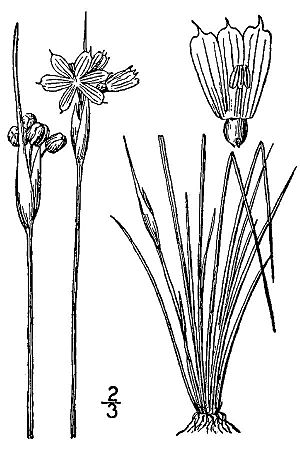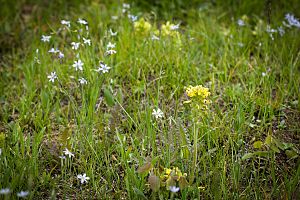Prairie blue-eyed grass facts for kids
Quick facts for kids Prairie blue-eyed grass |
|
|---|---|
 |
|
| A botanical illustration from Illustrated flora of the northern states and Canada by Nathaniel Lord Britton and Addison Brown | |
| Scientific classification | |
| Genus: |
Sisyrinchium
|
| Species: |
campestre
|
The prairie blue-eyed grass, also known as white-eyed grass, is a small plant that grows year after year. It's part of the iris family, which includes many beautiful flowers. This plant is native to the central United States and a small part of southern Manitoba in Canada. You can often find it growing in open, grassy areas like prairies and meadows.
About Prairie Blue-Eyed Grass
Prairie blue-eyed grass is a type of plant called an herbaceous perennial. This means it has soft, green stems (not woody like a tree) and its roots live through the winter, allowing the plant to grow back each spring. It's known for being quite tough, especially when it comes to dry weather. It can handle drought better than many other plants in its group.
What Does It Look Like?
This plant has delicate, pretty flowers and leaves that look a lot like grass.
- Flowers: The flowers are usually white or a very light blue. They have bright yellow centers, which makes them stand out. Each flower has six petal-like parts called tepals. These tepals are about 7 to 12.7 millimeters (about 0.3 to 0.5 inches) long. They have rounded ends but also a tiny sharp point right in the middle.
- Stems and Blooms: The flowers grow on thin stems called pedicels. These flower stems are flat and don't have branches. They usually grow to be about the same length as the leaves, or sometimes a little longer. The flowers grow in a cluster at the top, shaped like an umbel (which looks a bit like an umbrella). This cluster is protected by two leaf-like parts called bracts.
- Leaves: The leaves are long and thin, just like blades of grass. They can be anywhere from 3 to 10 inches (about 7.5 to 25 centimeters) long and only about 2 to 3 millimeters (0.08 to 0.12 inches) wide.
- Roots: The plant has a strong, fibrous root system. This helps it to stay firmly in the ground and find water.
How Does It Grow and Reproduce?
Prairie blue-eyed grass blooms in the late spring and early summer. Its flowers usually last for about three weeks. Over time, a single plant can produce new small plants, called offsets, around its base. This helps the plant form a thick, dense clump. This way, it can spread and cover more ground, making a beautiful display of its white or pale blue flowers.


